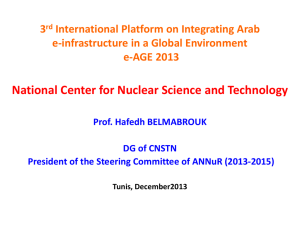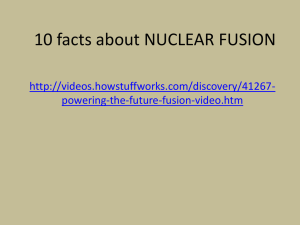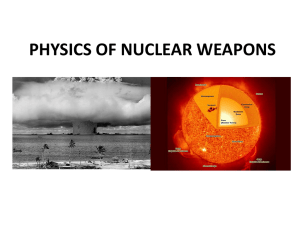Uses of Nuclear Radiation, Fission and Fusion
advertisement
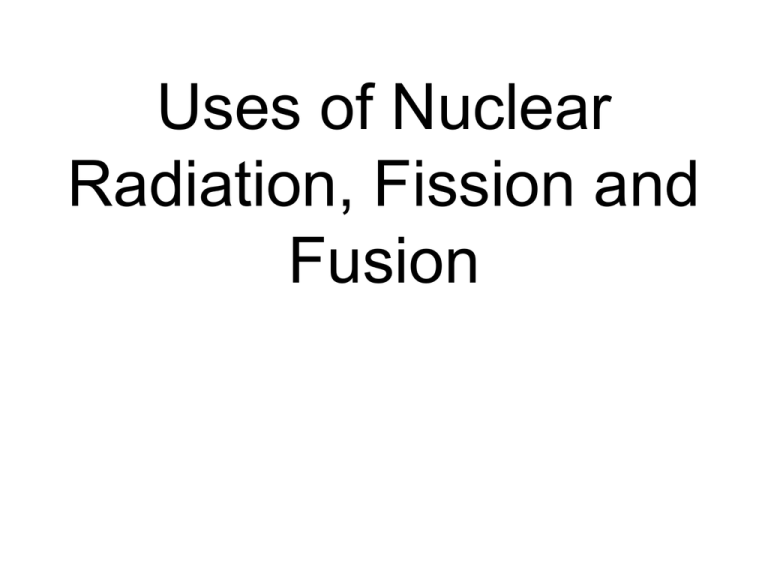
Uses of Nuclear Radiation, Fission and Fusion © 2003 John Wiley and Sons Publishers Figure 4.2: The penetrating power of radiation. © 2003 John Wiley and Sons Publishers Figure 4.4: The components of α rays, β rays, and γ rays. Origins of radiation exposure Natural Background (cosmic rays, earth minerals) 81% Medicine and Diagnostics 15% Consumer Products (televisions sets, smoke detectors) 4% Human Exposure to Radiation Uses of Nuclear Radiation/Energy • • • • Radioactive Dating Medicine – Chemotherapy – Power pacemakers – Diagnostic tracers Agriculture – Irradiate food – Pesticide – Fertilizer evaluation Energy – Fission – Fusion Carbon-14 dating 22,920 years ago 17,190 years ago 11,460 years ago 5730 years ago Present Radioisotopes in Medicine Radioisotopes like Tc-99 can be used to detect bone cancer. The Tc-99 accumulates in areas of abnormal bone metabolism and then detection of the nuclear radiation (gamma rays) show the location of the cancer. Radioisotopes in Agriculture -Radioactive tracers used to determine the effectiveness of fertilizers. - Cobalt-60 produces gamma rays that are used to irradiate food. Fission • Nuclear fission occurs when scientists bombard a large isotope with a neutron. • This collision causes the larger isotope to break apart into two or more elements. • These reactions release a lot of energy. • You can calculate the amount of energy produced during a nuclear reaction using an equation developed by Einstein: E=mc2 Chain Reaction Figure Nuclear Power Plants • If the neutrons can be controlled, then the energy can be released in a controlled way. Nuclear power plants produce heat through controlled nuclear fission chain reactions. • The fissionable isotope is contained in fuel rods in the reactor core. All the fuel rods together comprise the critical mass. • Control rods, commonly made of boron and cadmium, are in the core, and they act like neutron sponges to control the rate of radioactive decay. Nuclear Reactors • The reaction is kept in check by the use of control rods. • These block the paths of some neutrons, keeping the system from reaching a dangerous supercritical mass. Nuclear Power Plants (cont) • In the U.S., there are approximately 100 nuclear reactors, producing a little more than 20% of the country’s electricity. • Advantages – No fossil fuels are burned. – No combustion products (CO2, SO2, etc) to pollute the air and water. • Disadvantages – – – – Cost - expensive to build and operate. Limited supply of fissionable Uranium-235. Accidents (Three Mile Island & Chernobyl) Disposal of nuclear wastes Nuclear Reactors In nuclear reactors the heat generated by the reaction is used to produce steam that turns a turbine connected to a generator. What is Nuclear Fusion? • Nuclear Fusion is the energy-producing process taking place in the core of the Sun and stars • The core temperature of the Sun is about 15 million °C. At these temperatures hydrogen nuclei fuse to give Helium and Energy. The energy sustains life on Earth via sunlight Energy from Fusion 2 3 H H + 1 1 4 1 Energy He n + + 2 0 Nuclear Fusion • Fusion would be a superior method of generating power. – The good news is that the products of the reaction are not radioactive. – The bad news is that in order to achieve fusion, the material must be in the plasma state at several million kelvins. – Tokamak apparati like the one shown at the right show promise for carrying out these reactions. – They use magnetic fields to heat the material.
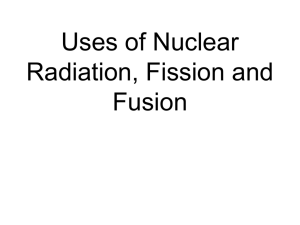






![The Politics of Protest [week 3]](http://s2.studylib.net/store/data/005229111_1-9491ac8e8d24cc184a2c9020ba192c97-300x300.png)

